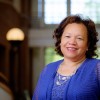This article is more than 5 years old.
This session, as were several during the conference, was paired up with similarly tracked themes, though I have to wonder how the previous session such a positive and encouraging one, was paired with the session entitled, “Bullying or Mobbing: Is It Happening in Your Library? The presenter identified bullying as repeated mistreatment especially snide sarcastic remarks. Mobbing is a specific type of bullying where a majority of people emotionally abuse and bully an individual. Advice to the audience included the need to document, stand up for yourself and avoid HR. The overtone here was more negative than I personally wanted to experience.
It was easy to move on to the next session on undergraduate student assistants and how they perceived their work experiences in the academic library as contributing to their social and academic integration in college.
Student use in libraries can be tallied up as about 50% academic and 50% social. How then can libraries use the statistical data obtained from observations of student patterns and behaviors to plan and strategize for facility design and services. This may be an untapped resource.
Recruiting and Retaining the Library workforce of tomorrow was a sharing of results on a joint research project conducted by North Carolina at Chapel Hill’s School of LIS, Barbara Moran and South Carolina’s Paul Solomon. Together they surveyed LIS graduates from 1964 to 2005 and provided information beneficial to both recruiting and retaining librarians in academic libraries. All of the graduates were from North Carolina LIS programs The study sought to find out why they came and then if they left, then why. A web survey was administered to some 7,566 former students. Thirty five percent responded. NC graduates are currently working in all 50 fifty states and in 14 foreign countries. For the question why did you choose this as your profession?, the following answers came:
Good fit with my interest – 93% —-Wanted to make a difference – 66%
Like working with people – 68% —-Flexible career options – 56%
Worked in a library – 55%
The question, why did you leave? produced this list of varying reasons:
More opportunities for growth —Challenging projects
Salary —-Moved —-Working environment
Benefits —-Management issues —Technology
Working hours
In summary it appears that even in a working career, “variety is the spice of life.”
Facilitator for the luncheon roundtable discussion I chose to attend, Michael Pasqualoni sought to re-envision efficiency and outcomes during the Academic librarian search process. Topics covered addressed the need for library search committees to accept their role in selling the library to the applicant, how to gain enough information relative to the applicants skills, experiences and visions and how to write job descriptions that match the Library’s mission yet broad enough to not box the applicant in to one tiny area.
The afternoon featured several of our ZSR librarians in the spotlight. I tried to catch them all. Lauren P. spoke on career planning, knowing where you want to be in your career and then mapping your path there. Lynn shared details on the “Replication of the OCLC Perceptions Study” that WFU and UNC-G conducted together. Roz talked about the wonders of Google Docs. Each topic was well received, attracting great attendance and curious responders filled with lots of questions. I was mighty proud!
But there was time for one more final session. For this paper the authors choose to examine statistical data collected from NCES and ARL to see if budgeting trends matched some of the ACRL top ten assumptions. ACRL assumptions compared were #1, Libraries will become increasingly more digital; #2 more non MLS professionals; #3 more dollars will be spent on purchasing digital content and #7 libraries will see a shift from traditional services. Among their findings were numbers indicating that reference transactions are down by 35 %, circulation numbers declining by 10% and gate counts up by 14 %. Presenters sparked my interest and I can hardly wait to do more comparative analysis on the data ZSR has collected. I have more notes on all and am happy to share.
